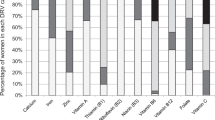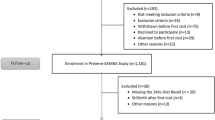Abstract
Objective: To describe dietary intakes and nutrient adequacy during pregnancy in a sample of Peruvian women.
Design: Descriptive, observational prospective study, nested within a double-masked, controlled, zinc-supplementation trial during pregnancy.
Setting: Hospital Materno-Infantil ‘Cesar Lopez Silva’, in Villa El Salvador, an impoverished shantytown in Lima, Peru.
Subjects: A subsample of women enrolled in the larger trial. These women all had low-risk singleton pregnancies and were receiving prenatal care at the study hospital. A total of 168 24-h dietary recalls were collected at 10–24 weeks gestation and 120 recalls were collected at 28–30 weeks gestation.
Results: Median intakes of protein, riboflavin, niacin, vitamin C and phosphorus met the current US RDA for pregnancy, whereas intakes of thiamin, folate, vitamin A, calcium, iron and zinc were well below the recommendations at both time periods. Dietary intake of energy (mostly from carbohydrates) showed a significant increase from 10–24 to 28–30 weeks gestation, as did intakes of folate and vitamin A. The nutrients with the highest estimated prevalences of inadequacy at both points in pregnancy were iron (93%), zinc (88–80%), folate (87–74%) and calcium (86–82%).
Conclusion: Usual dietary intakes were found to be relatively adequate in terms of their energy and protein contents. However, high prevalences of inadequate intakes were estimated, particularly for iron, zinc and calcium.
Sponsorship: Supported by DAN-5116-A-00-8051-00 and HRN-A-00-97-00015-00, cooperative agreements between USAID/OHN and The Johns Hopkins University.
This is a preview of subscription content, access via your institution
Access options
Subscribe to this journal
Receive 12 print issues and online access
$259.00 per year
only $21.58 per issue
Buy this article
- Purchase on Springer Link
- Instant access to full article PDF
Prices may be subject to local taxes which are calculated during checkout

Similar content being viewed by others
References
Brown JE, Buzzard M, Jacobs Jr DR, Hannan PJ, Kushi LH, Barosso GM & Schmid LA (1996): A food frequency questionnaire can detect pregnancy-related changes in diet. J. Am. Diet Assoc. 96, 262–266.
Carboné P, Sobreviela M, Jiménez D, Martínez C & Pocoví M (1992): Hair zinc and dietary zinc intake during pregnancy and puerperium. Eur. J. Clin. Nutr. 47, 103–108.
Caulfield LE, Zavaleta N & Figueroa A (1999a): Maternal zinc supplementation does not affect size at birth or pregnancy duration in Peru. J. Nutr. 129, 1563–1568.
Caulfield LE, Zavaleta N & Figueroa A (1999b): Adding zinc to prenatal iron and folate supplements improves maternal and neonatal zinc status in a Peruvian population. Am. J. Clin. Nutr. 69, 1257–1263.
Cid-Ruzafa J, Caulfield LE, Barrón Y & West SK (1999): Nutrient intakes and adequacy among an older population on the eastern shore of Maryland: the Salisbury Eye Evaluation. J. Am. Diet Assoc. 99, 564–571.
Department of Agriculture, Agricultural Research Service (1998): USDA Nutrient Database for Standard Reference, Release 12. Nutrient Data Laboratory Home Page, http://www.nal.usda.gov/fnic/foodcomp.
Ferguson EL, Gibson RS, Thompson LU & Ounpuu S (1989): Dietary calcium, phytate and zinc intakes and the calcium, phytate and zinc molar ratios of the diets of a selected group of East African Children. Am. J. Clin. Nutr. 50, 1450–1456.
Flores M, Melgar H, Cortés C, Rivera M, Rivera J & Sepúlveda J (1998): Consumo de energía y nutrimentos en mujeres mexicanas en edad reproductiva. Salud Pública México. 40, 161–171.
Gibson RS & Huddle J-M (1998): Suboptimal zinc status in pregnant Malawian women: its association with low intakes of poorly available zinc, frequent reproductive cycling and malaria. Am. J. Clin. Nutr. 67, 702–709.
Institute of Medicine Committee on Micronutrient Deficiencies. (1998): Summary. In Prevention of Micronutrient Deficiencies: Tools for Policymakers and Public Health Workers, eds Howson CP, Kennedy ET & Horwitz A. Washington, DC: National Academy Press. http://books.nap.edu/html/micronutrient/.
Mora JO & Mora OL (1998a): Micronutrient deficiencies in Latin America and the Caribbean: Iron Deficiency Anemia. Washington, DC: USAID/WHO.
Mora JO & Mora OL (1998b): Micronutrient deficiencies in Latin America and the Caribbean: Iodine, Calcium and Zinc. Washington, DC: USAID/WHO.
National Research Council (NRC) (1986): The probability approach. In Nutrient Adequacy. Assessment Using Food Consumption Surveys, Chapter 5, pp 25–40. Washington, DC: National Academy Press.
Nicolini (1998): Qué cocinaré hoy? Lima, Peru: Alicorp SA.
Recommended Dietary Allowances (RDA) (1989): RDA, 10th Edition. Washington, DC: National Academy Press.
Siega-Riz AM, Herrmann TS, Savitz DA & Thorp J (2001): The frequency of eating during pregnancy and its effect on preterm delivery. Am. J. Epidemiol. 153, 647–652.
StataCorp. (1997): Stata Statistical Software: Release 5.0. College Station, TX: Stata Corporation.
The WorldFood Dietary Assessment System (NFOOD) (1997): WFOOD, Version 2.0. Berkeley, CA: University of California, Berkeley. [computer program].
Zavaleta N & Berlanga M del R (1996): Patrones de alimentación y niveles de consumo de nutrientes en mujeres gestantes. Lima Metropolitana, 1991–1992. In Investigaciones en salud: contribuiciones del Convenio OPS-CONCYTEC, ed. CC Palacios, pp 153–166. Lima: OPS.
Zavaleta N, Caulfield LE & Garcia T (2000): Changes in iron status during pregnancy in Peruvian women receiving prenatal iron and folate supplements with or without zinc. Am. J. Clin. Nutr. 71, 956–961.
Author information
Authors and Affiliations
Corresponding author
Rights and permissions
About this article
Cite this article
Sacco, L., Caulfield, L., Zavaleta, N. et al. Dietary pattern and usual nutrient intakes of Peruvian women during pregnancy. Eur J Clin Nutr 57, 1492–1497 (2003). https://doi.org/10.1038/sj.ejcn.1601716
Published:
Issue Date:
DOI: https://doi.org/10.1038/sj.ejcn.1601716



